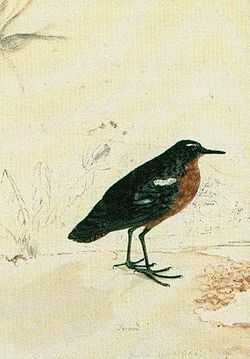Tahiti sandpiper
| Tahiti sandpiper | |
|---|---|
 | |
| Forster's drawing | |
| Conservation status | |
| Scientific classification | |
| Kingdom: | Animalia |
| Phylum: | Chordata |
| Class: | Aves |
| Order: | Charadriiformes |
| Family: | Scolopacidae |
| Genus: | Prosobonia |
| Species: | † P. leucoptera |
| Binomial name | |
| Prosobonia leucoptera (Gmelin, 1789)[2] | |
| Synonyms | |
|
Tringa leucoptera Gmelin, 1789 | |
The Tahiti sandpiper or Tahitian sandpiper (Prosobonia leucoptera) is an extinct member of the large wader family Scolopacidae that was endemic to Tahiti in French Polynesia.
It was discovered in 1773 during Captain Cook’s second voyage, when a single specimen seems to have been collected, but it became extinct in the nineteenth century. Only one museum specimen is known to exist. The bird's name in the Tahitian language was transcribed as toromē.
Description


Based on Zusi & Jehl (1970):[3] A small (some 18 cm long), plain-colored sandpiper, brown below, darker above, with a white wing patch. Top and sides of head and neck to wings and back sooty brown, darker on back and wings. A small white patch behind and above the eye. Chin buffish white. Lores, rump and underside rusty. Wing coverts with some rusty edging. Remiges with paler inner surfaces. Underside of wing dusky brown with paler edges to coverts. A crescent-shaped white patch formed by tertiary coverts; smaller on the underside of the wing. Ten primaries, twelve rectrices. Central tail feathers sooty brown with rusty tips; outer ones rusty with sooty brown barring.
Bill blackish, lower mandible slightly paler, pointed, thin and short, rather like in an insectivorous passerine than a wader. Legs greenish-hued pale straw color. Toes unwebbed. A slim pale rusty ring around the eye. The iris was very dark brown.
The Tahiti sandpiper is believed to have occurred near small streams.
Two probable specimens taken on Moorea by William Anderson between September 30 and October 11, 1777, formed the basis for the description of the Moorea sandpiper. Three specimens mentioned by John Latham in 1787 all differed from one another, but the single remaining one, RMNH 87556, cannot be positively identified with any of them. How it came into the possession of the museum cannot be retraced with complete certainty, but it probably was acquired in 1819 with other specimens from Georg Forster.[4] There also exists a painting by Forster, drawn from the original specimen.
At any rate, the specimen agrees better with the Tahiti bird in Forster's painting. The Moorea bird—of which another painting, by William Ellis, and a plate by J. Webber, supposed to depict the other specimen, constitute all remaining evidence—differs in the color of wings and head. Whether these two forms were species, subspecies, or simply variants due to age or sex cannot be determined with certainty, but for the present they are more often treated as different species than not.
Bones of a related form have been found on Mangaia in the Cook Islands. It is not likely that they will be studied anytime soon: a scientific description would require either successful extraction and analysis of DNA from both the bones and the Leiden specimen (which would risk being damaged during extraction of the tissue sample), or the collection of a sufficient amount of material from Tahiti or Moorea to determine the Mangaia bird's affiliation by analysis of the osteology. Both possibilities seem very remote.
References
- ↑ BirdLife International (2012). "Prosobonia leucoptera". IUCN Red List of Threatened Species. Version 2013.2. International Union for Conservation of Nature. Retrieved 26 November 2013.
- ↑ Gmelin, Johann Friedrich (1789): [Description of Prosobonia leucoptera]. In: Systema Naturae per regna tria naturae secundum classes, ordines, genera, species, cum characteribus, differentiis, synonymis, locis (13th ed.) 1, part II: 678. Georg Emanuel Beer, Lipsiae [Leipzig].
- ↑ Zusi, Richard L. & Jehl, Robert R., Jr.; Jehl (1970). "The systematic relationships of Aechmorhynchus, Prosobonia and Phegornis (Charadriiformes; Charadrii)". Auk 87 (4): 760–780. doi:10.2307/4083710.
- ↑ Stresemann, Erwin (1950). "Birds collected during Capt. James Cook's last expedition (1776–1780)". Auk 67 (1): 66–88. doi:10.2307/4080770.
Further reading
- Greenway, James C. (1967): Tahitian Sandpiper. In: Extinct and Vanishing Birds of the World (2nd ed.): 263–264. Dover Publications, New York.
- Hayman, Peter; Marchant, John & Prater, Tony (1986): Shorebirds: an identification guide to the waders of the world. Houghton Mifflin, Boston. ISBN 0-395-60237-8
- Latham, John (1785): [White-winged Sandpiper]: In: A general synopsis of birds 3: 172, plate 82. London.
- Latham, John (1824): [White-winged Sandpiper]: In: A general history of birds 9: 296.
External links
- 3D view of specimen RMNH 87556 at the Naturalis, Leiden (requires QuickTime browser plugin).
- BirdLife species factsheet.
